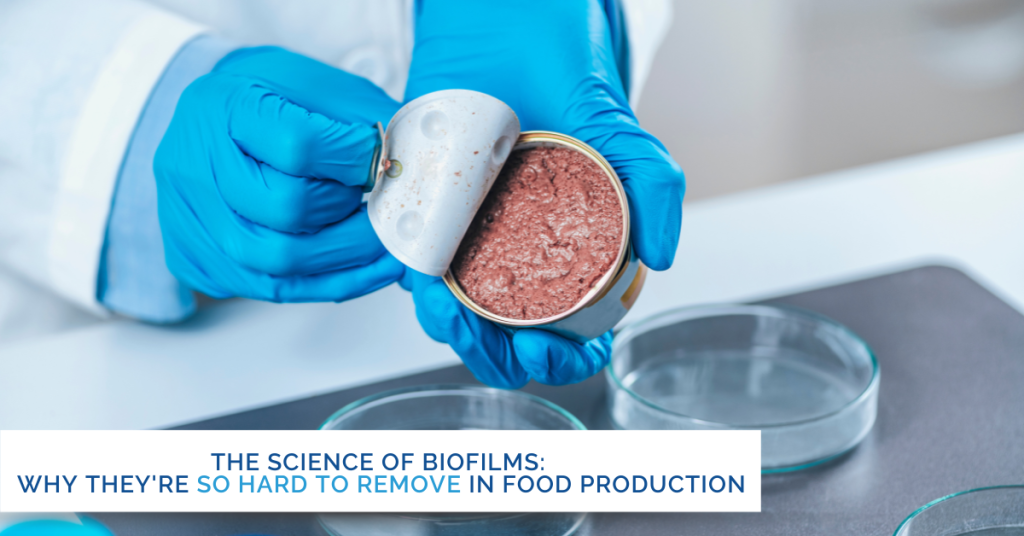In the food processing industry, biofilms present a persistent and costly challenge. These complex microbial communities thrive on food contact surfaces, resisting rigorous cleaning and disinfection protocols. To effectively combat biofilms, it’s crucial to understand their biology, why they resist cleaning, and the implications for food safety and operational efficiency.
What Are Biofilms?
Biofilms are structured communities of microorganisms, primarily bacteria, embedded within a self-produced extracellular polymeric substance (EPS) matrix. This matrix, often referred to as “slime,” consists of polysaccharides, proteins, lipids, and extracellular DNA. Biofilms adhere to surfaces, such as stainless-steel equipment, plastic conveyor belts, or rubber seals, creating a tenacious and protected environment for microbial survival.
In food production, biofilms often form in moist environments where organic matter is present. Once established, they can house pathogenic bacteria like Listeria monocytogenes, Salmonella spp., and Escherichia coli, posing significant risks to public health and regulatory compliance.
The Biology Behind Biofilm Formation
The formation of biofilms follows a well-defined sequence:
- Attachment: Free-floating bacteria adhere to a surface using weak, reversible interactions, such as van der Waals forces. Over time, this attachment becomes irreversible through the production of adhesion molecules.
- Maturation: Once adhered, bacteria begin to divide and secrete the EPS matrix. The matrix anchors the biofilm and provides a scaffold for microbial communication and nutrient exchange.
- Dispersal: Portions of the biofilm detach, releasing bacteria into the environment to colonize new surfaces.
This biological lifecycle makes biofilms dynamic and resilient, capable of reestablishing themselves even after partial removal.
Why Are Biofilms So Hard to Remove?
- Physical Protection
The EPS matrix acts as a barrier, shielding the embedded microorganisms from environmental stressors, including cleaning agents and disinfectants. Many solutions struggle to penetrate this matrix effectively.
- Chemical Resistance
Microbes can alter their metabolic states within the biofilm, often becoming dormant. Dormant cells are less susceptible to agents that typically target active cellular processes.
- Genetic Adaptability
Biofilms facilitate horizontal gene transfer among bacteria, enabling the spread of resistance genes. This adaptability enhances their ability to withstand chemical and physical treatments over time.
- Surface Interactions
Biofilms adhere tenaciously to surfaces, exploiting micro-abrasions or imperfections that cleaning agents might overlook. Their adhesion makes physical removal difficult without damaging the underlying material.
Implications for Food Processing
In food production, biofilm-related contamination has dire consequences:
- Food Safety Risks: Pathogens within biofilms can transfer to food products, leading to outbreaks of foodborne illness. A 2019 study published in Applied and Environmental Microbiology found that biofilm-associated Listeria was 1,000 times more resistant to sanitizers than planktonic cells.
- Operational Costs: Persistent biofilms increase cleaning, disinfecting and maintenance expenses. Repeated equipment failures due to biofilm-induced corrosion exacerbate these costs.
- Regulatory Challenges: Non-compliance with food safety standards, such as those outlined by the FDA or USDA, can result in recalls, financial losses, and reputational damage.
Strategies to Address Biofilms
- Enhanced Cleaning Protocols
Employ mechanical cleaning methods, such as high-pressure water jets or ultrasonic cleaning, to disrupt biofilms’ physical integrity. Pair these with enzymatic cleaners that break down the EPS matrix.
- Innovative Material Science Solutions
Kismet Clean utilizes a specialized ceria-silver nanozyme that has been shown to address challenges posed by biofilms. A recent Biomaterials publication highlights the mechanism of action of the ceria-silver nanozyme as outlined below:
- Targeted Disruption: The nanozyme’s cationic surfaces interact with biofilms, disrupting their structural integrity and balance.
- Localized Activity: The formulation destabilizes biofilm matrices while promoting surface cleanliness by generating reactive oxygen species, including hydrogen peroxide.
- Catalytic Efficiency: The cerium-silver interface ensures that biofilms are unable to reestablish on treated surfaces over extended periods, as demonstrated in industry-specific studies.
- Surface Modifications
Apply advanced coatings or modify surface textures to reduce bacterial adhesion. Research published in Frontiers in Microbiology demonstrates that certain nano-textured surfaces can prevent initial bacterial attachment, minimizing biofilm formation.
- Monitoring and Prevention
Utilize biosensors to detect early biofilm formation, allowing for timely intervention. Preventative measures, such as strict humidity control and regular equipment maintenance, reduce the likelihood of biofilm establishment.
Conclusion
Biofilms represent one of the most formidable challenges in food processing. Their biological complexity and resistance mechanisms make them difficult to manage, demanding innovative approaches and a deep understanding of their science. Kismet Clean’s ceria-silver nanozyme provides an advanced material science solution, offering a comprehensive approach to enhance cleaning protocols and maintain cleaner surfaces over time. By incorporating such technologies alongside enhanced cleaning protocols and preventative strategies, food production facilities can achieve safety, compliance, and operational excellence.
Contact us today for more information on how Kismet Clean can support your biofilm management strategies.
Sources:
- Donlan, R. M. (2002). Biofilms: Microbial Life on Surfaces. Emerging Infectious Diseases, 8(9), 881–90.
- Bridier, A., et al. (2011). Resistance of bacterial biofilms to disinfectants: a review. Biofouling, 27(9), 1017-1032.
- Whitehead, K. A., & Verran, J. (2015). Formation, architecture, and functionality of microbial biofilms in the food industry. Current Opinion in Food Science, 2, 84-91.
- Pugazhendhi, A. S., et al. (2024). A neoteric antibacterial ceria-silver nanozyme for abiotic surfaces. Biomaterials, 307, 122527.

